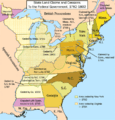U.S. territory facts for kids
A U.S. territory is like a special area or island that belongs to the United States. Even though it's part of the U.S., it often has its own local government and rules. People born in most U.S. territories are U.S. citizens, but they usually can't vote for the U.S. President. They also don't have full voting representatives in the U.S. Congress.
The current U.S. territories include Puerto Rico, American Samoa, the Northern Mariana Islands and Guam.
Understanding U.S. Territories
What Makes a Territory Special?
A U.S. territory is a place that is owned by the United States but is not one of the 50 states. These areas have their own local governments. However, the U.S. Congress still has power over them. This means Congress can pass laws that affect the territories.
How Territories Differ from States
The biggest difference between a state and a territory is representation. States have full voting members in the U.S. Congress. They also get to vote for the President and Vice President. Territories, on the other hand, usually have non-voting representatives in Congress. Their citizens cannot vote in the U.S. presidential election.
Where Are U.S. Territories Located?
Most U.S. territories are islands located in the Caribbean Sea or the Pacific Ocean. These locations are often important for trade or military reasons. They also have unique cultures and beautiful natural environments.
Exploring Current U.S. Possessions
The main U.S. territories today are:
- Puerto Rico: A large island in the Caribbean, known for its rich history and vibrant culture.
- Guam: An island in the western Pacific, important for its strategic military base.
- American Samoa: A group of islands in the South Pacific, famous for its traditional Polynesian culture.
- Northern Mariana Islands: A chain of islands in the Pacific, close to Guam.
- U.S. Virgin Islands: A group of islands in the Caribbean, popular for tourism.
A Look at Territory History
The United States gained most of its territories through different historical events. Many were acquired after wars or through purchases. For example, Puerto Rico and Guam became U.S. territories after the Spanish–American War in 1898. The U.S. Virgin Islands were bought from Denmark in 1917.
How the U.S. Acquired These Lands
The process of acquiring territories often involved treaties or agreements. These agreements transferred control of the land to the United States. Over time, some territories became states, like Hawaii and Alaska. Others, like the ones we have today, remain territories.
Life for People in Territories
People living in U.S. territories are generally U.S. citizens. This means they can travel freely to the mainland U.S. and have many of the same rights as other citizens. However, they pay federal taxes differently and do not have full voting rights in national elections.
Rights and Responsibilities of Citizens
Citizens in territories follow U.S. laws and local laws. They serve in the U.S. military and carry U.S. passports. While they contribute to the nation, their political representation at the federal level is limited. Each territory has its own unique relationship with the U.S. government.
Images for kids
-
Original copy of the Constitution.
See also
 In Spanish: Ámbito territorial de Estados Unidos para niños
In Spanish: Ámbito territorial de Estados Unidos para niños






